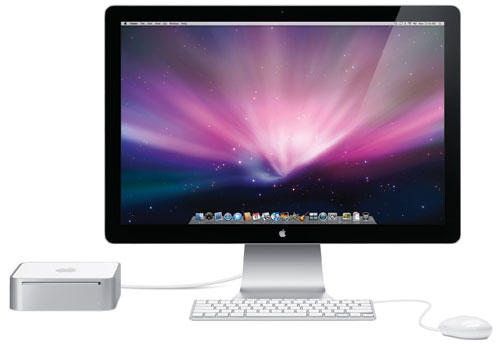Hosted by site sponsor WebMate.
Intel Mac mini Q&A - Published March 7, 2009
To be notified of new Q&As, sign up for EveryMac.com's bimonthly email list.
What are the differences between the "Early 2009/NVIDIA" Mac mini "Core 2 Duo" and the Mac mini models they replaced?
Please note that all systems mentioned in this Q&A have been discontinued. The "Early 2009/NVIDIA" Mac mini models were replaced by the "Late 2009" Mac mini line on October 20, 2009.
The differences between the two Mac mini "Core 2 Duo" 2.0 (Early 2009/NVIDIA) configurations are quite modest but the differences between the "Early 2009/NVIDIA" model and the ones that proceeded it are far more substantial than it appears at first glance.

Photo Credit: Apple, Inc.
Like their predecessors, the "Early 2009/NVIDIA" Mac mini models have their internal components enclosed in a tiny and elegant 2.9 lb, 6.5 inch square, two inch tall case.
Externally, the "Early 2009/NVIDIA"and the "Mid-2007" Mac mini models look identical from the front, but the connectivity on the back has been changed quite a bit. Most significantly, the "Mid-2007" Mac mini models have a single DVI port and the "Early 2009/NVIDIA" models have dual video ports -- Mini-DVI and Mini DisplayPort -- and both ports can be used to simultaneously drive two displays, the first time that the Mac mini series has supported dual displays.
Additionally, the "Early 2009/NVIDIA" models have 5 USB 2.0 ports and a Firewire "800" port compared to 4 USB 2.0 ports and a Firewire "400" port on the earlier Intel-based models. The remaining ports -- Gigabit Ethernet, a combined "optical digital audio input/audio line in minijack", and a "optical digital audio output/headphone out minijack" are the same. The "Early 2009/NVIDIA" models support 802.11n and Bluetooth 2.1+EDR and the "Mid-2007" models support 802.11g and and the earlier Bluetooth 2.0+EDR standard.
Internally, the "Early 2009/NVIDIA" Mac mini models also use a faster architecture than the "Mid-2007" models. The "Early 2009/NVIDIA" line up has a newer processor (albeit with a smaller L2 cache than the higher-end "Mid-2007" model), a faster system bus (1066 MHz up from 667 MHz), faster memory (1066 MHz DDR3 compared to 667 MHz DDR2), and faster integrated graphics (a NVIDIA GeForce 9400M compared to a Intel GMA 950).
By default, "Early 2009" Mac mini models also are configured by default with a faster "SuperDrive" and the high-end configuration is configured with more memory and a larger hard drive.
The major differences between the "Early 2009" and "Mid-2007" models are summarized below:
| "Mid-2007" Mac mini | "Early 2009" Mac mini | |
|---|---|---|
| Processor Type: | Core 2 Duo (T5600, T7200) | Core 2 Duo (P7350) |
| Processor Speed: | 1.83 GHz, 2.0 GHz | 2.0 GHz |
| L2 Cache: | 2 MB, 4 MB | 3 MB |
| Bus Speed: | 667 MHz | 1066 MHz |
| RAM Type: | PC2-5300 DDR2 | PC3-8500 DDR3 |
| Standard RAM: | 1 GB | 1 GB, 2 GB |
| Hard Drive: | 80 GB, 120 GB | 120 GB, 320 GB |
| Optical Drive: | 2.4X DL "SuperDrive" | 8X DL "SuperDrive" |
| Video Type: | Intel GMA 950 | NVIDIA GeForce 9400M |
| Integrated VRAM: | 64 MB | 128 MB, 256 MB |
| AirPort: | 802.11a/b/g | 802.11a/b/g/n |
| Bluetooth: | 2.0+EDR | 2.1+EDR |
| Apple Order No: | MB138LL/A, MB139LL/A | MB463LL/A, MB464LL/A |
| Price: | US$599, US$799 | US$599, US$799 |
In the US, site sponsor Adorama sells new Mac mini models with free shipping. Other World Computing and JemJem sell used and refurb Mac mini models at bargain prices with free shipping, as well. Finally, if you need to sell a Mac mini, A+ BBB-rated Cash for Your Mac will buy your older Mac mini with an instant quote and prompt payment.
In the UK, site sponsor Hoxton Macs sells used Mac mini models with a one-year warranty and free next day delivery throughout the UK. Delivery across Europe also is available starting at just £9.99 for two-day delivery to France and Germany.
In Australia, site sponsor Mac City likewise may have used Mac mini models available at low prices and with a free warranty and fast shipping across Australia.
Please refer to the Ultimate Mac Comparison feature to dynamically compare any Mac mini model to any other G3 or later Mac.
Permalink | Report an Error/Typo | Sign Up for Site Update Notices
Established in 1996, EveryMac.com has been created by experts with decades of experience with Apple hardware. EveryMac.com includes, and always has included, original research incorporating detailed, hands-on inspection of packaging, computers, and devices as well as extensive real-world use. All information is provided in good faith, but no website or person is perfect. Accordingly, EveryMac.com is provided "as is" without warranty of any kind whatsoever. EveryMac.com, and the authors thereof, shall not be held responsible or liable, under any circumstances, for any damages resulting from the use or inability to use the information within. For complete disclaimer and copyright information please read and understand the Terms of Use and the Privacy Policy before using EveryMac.com. Copying, scraping, or use of any content without expressed permission is not allowed, although links to any page are welcomed and appreciated.
